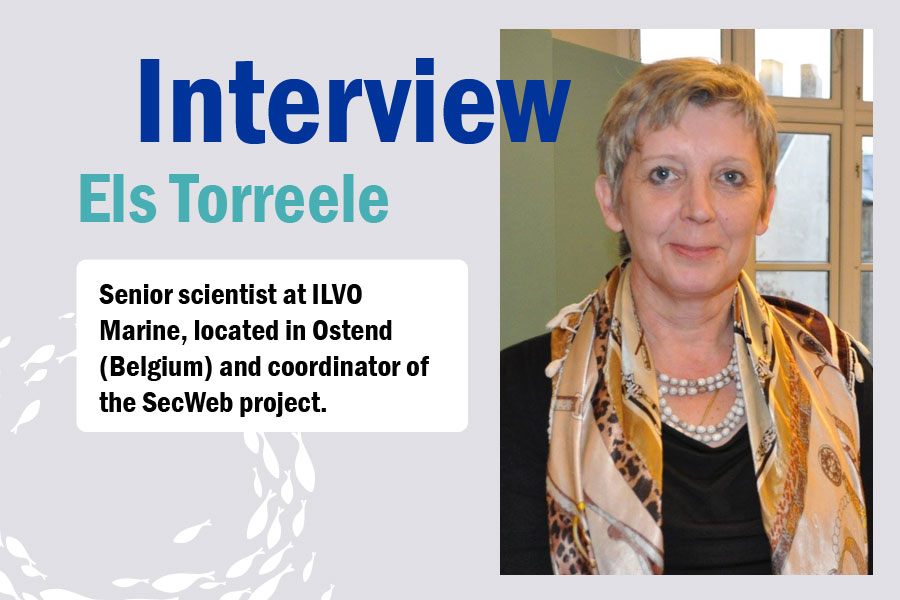Before starting, a brief introduction of the protagonist of this interview.
I am Els Torreele, senior scientist at ILVO Marine, located in Ostend (Belgium) and coordinator of the SecWeb project. In my career I’ve been working in fisheries Data Collection, the use of data for different purposes and in diverse advice given by a range of organizations and Frameworks (ICES, STECF, MSFD, …). In recent years, I have been chairing twice the Regional Coordination Group North Sea and Eastern Arctic (RCG NSEA) and the Regional Coordination Group North Atlantic, North Sea and Eastern Arctic (RGC NANSEA). Additionally, during the summer 2020 I was approached to take the lead on putting together the SecWeb project proposal, which was approved by the end of 2020, started in January 2021and it will run until December 2022.
How do you think the work in SecWeb will strengthen the Regional Cooperation in the field of fisheries data collection?
The SecWeb project aims at establishing an efficient and recognizable way of communication regarding the work and outputs realized by the different RCGs. SecWeb is aimed at the RCGs and at the end-users of the RCGs’ work. One of the challenges we face in the fisheries data collection framework (DCF) is to achieve effective regional coordination not only within a region or among the organizations involved, but even (where relevant) across different regions. A systematic interaction within the different RCGs is crucial to overcome this challenge, and this is where the tools under development in SecWeb can make a real difference.
Although the Secretariat service is still under development, we are aware that progress is being tested through a case study. Which do you think are the most common challenges about the orientation and needs for the Secretariat support service in the future?
The main challenge for the Secretariat will be to add continuity to the working procedures when RCGs chairs are changing, once their mandate is over. This would also help smoothing the progress towards fluent regional cooperation and it would ensure a stable quality standard of the work, independent of who is the RCG chair each time and in each case.
The need for a Secretariat is even more imminent as the bulk of the RCGs work, is primarily carried out in sub-groups working intersessional between annual meetings. The intersessional work requires constant follow ups by the RCGs’ chairs to ensure work is on track.
Additionally, the Rules of Procedures (RoPs) for the RCGs imply increased administrative responsibilities (including deadlines for documents, reports etc.) for the RCGs’ Chairs. For this, the most pressing challenge for the Secretariat will be to have a continuous up to date overview of recommendations and agreements (tracking progress towards them), to support the chairs to prepare the annual report in accordance with the RoPs, and to keep track on the sub-groups’ work. In addition, the Secretariat has to check that the work plans for the sub-groups are concluded, which implies the follow up of their contributions to the draft report of the respective RCGs (the Secretariat supports the chairs to “hunt” contributions to the report from RCG participants) so that results are delivered in time for the RCG annual meetings.
Keeping in mind that the website development is work in progress how do you visualise it for the future? We see the web as a very promising tool for all the stakeholders in and beyond the Regional Coordination Groups (RCGs), from this point of view which are the most relevant benefits that it is going to bring to its different target users?
The work done by the RCGs is invisible for most people who are not directly involved. To some extent this is due to how the RCGs are reporting but also to the fact that the reports are hard to find for stakeholders outside the “DCF machinery”. As a result, the visibility of the outcome of the work done within the RCGs is limited to RCGs participants, which in the long run may hamper regional coordination and end-user interaction.
The RCG reports are published on the EU JRC website but they do not reach a wide audience. One reason could be that the reports are long and cover an array of topics, which vary year after year. Another reason could be the limited visibility of the EU JRC website, which is manly attracting the same users as the RCGs. For people who is not attending the RCGs meetings is it simply difficult to know if the contents of the reports are of interest to them or not. For people outside the “DCF world”, it might not be obvious where to look for the information.
The dedicated website and the structure of the website will be a ‘game – change’ in this situation.
The RCGs website will be updated on a regular basis by the Secretariat. Information for each specific RCG such as ToRs, scope maps, participating countries and institutions, reports and much more, can easily be found under the RCGs pages (https://www.fisheries-rcg.eu/rcgs/). Additionally, information will be open for all kinds of users, and if for example, agreed reference lists or any recent developments regarding the DCF are published elsewhere, the website shall contain the links.
For more details, please visit the website at www.fisheries-rcg.eu
If you had to define a main target audience for which it would be crucial to clarify the role and scope of activities of the RCGs and the Intersessional Subgroups (ISSGs), how would you define it and why?
The targeted audience beyond the RCG participants is, at least for the short and medium term, other people and organizations with a prior interest and knowledge in fisheries e.g. data collection end-users, managers, NGOs, advisory councils, industries…
